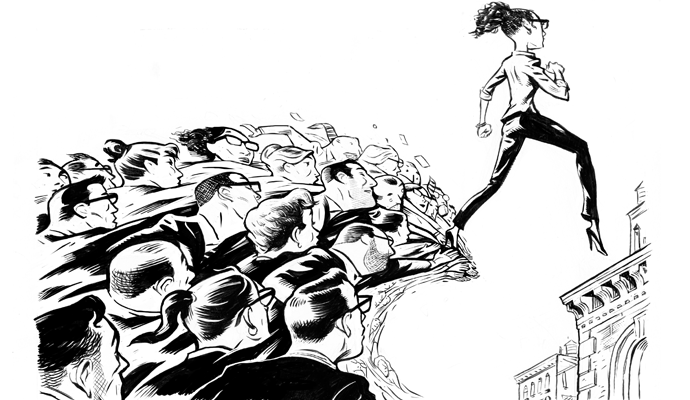6 Ways to Challenge Your Leadership Assumptions
A decades-old study of culture in leadership provides some insight on what underlies your beliefs about leaders and what they do.
The need to question underlying assumptions is one of the enduring lessons from my undergraduate study of economics. Holding variables constant, forecasting external conditions, and making presumptions about behavioral patterns can make a bad idea look great or deflate an otherwise sound plan. And if there’s one thing I’ve learned since my college days, it’s that assumptions can have just as big an impact on qualitative areas—such as leadership—as they do on quantitative endeavors.
I recently came across a paper written almost two decades ago in which Miles Bryant, a professor of education administration at the University of Nebraska–Lincoln, compared Western leadership beliefs to those of Native Americans from six Plains tribes. Bryant and a group of graduate students sought to learn how culture figures in conceptions of leadership. The resulting paper tied leadership closely to role and rank in both traditions (see my column, “Let’s Just Stop Calling Them Leaders” for the counterargument). While his sample set is small—his team interviewed only 12 individuals—he found six distinct differences that are useful for examining leadership assumptions. I am not arguing that either set of beliefs is “right” (nor did Bryant). The variances are simply a catalyst for thinking more deeply about what makes an effective leader.
“Leadership,” as we most often use the term, is not universal; it is an Anglo-Saxon concept dating to Carlyle’s Great Man Theory in the 19th century. Leadership was not something generally associated with business executives until late in the 20th century. Historian James MacGregor Burns’s landmark 1978 book, Leadership, carefully examined political and social leaders from Napoleon to Mao, but made only a few references to business people as leaders. Today, leadership seems to be the subject of every fifth tweet. The term is ubiquitous. But do we truly understand what we mean when we use it? Bryant’s six findings could help us find the answer.
Today, leadership seems to be the subject of every fifth tweet. The term is ubiquitous.
1. How does hierarchy fit into your view of leadership? The first difference Bryant found between Western leadership beliefs and those of the Plains Tribes was around leaders and hierarchy. Whereas mainstream Western thinking holds that a group needs someone in charge if it is to accomplish its tasks effectively and efficiently, the Native Americans Bryant documented saw each person as important, with a distinctive contribution to make to the success of the group. “No single entity supervises other individual entities in some hierarchal fashion,” he wrote. Of course, our organizations have been getting less hierarchical for several years now. Management thought leader Gary Hamel has been advocating for decentralized leadership, and companies such as WL Gore and Herman Miller have been experimenting with it in their organizations as a route to greater innovation, engagement, and customer satisfaction.
2. As we navigate the Anthropocene age—so dubbed because of the impact humans have had on the environment—how might the Native American view of a leader’s value inform how we think about our relationship to the larger system in which we operate? The second variance that Bryant identified was around the leader as a source of wisdom versus a creator of organizational value. He found that the Native Americans he studied saw value in all things and that a leader grew into that role through lifelong study of how the world works. It was not about the ability to exploit resources for tangible value, but rather the ability to understand the system and how to thrive in harmony with it.
3. What does your approach to development say about the level of trust you have in others? Bryant also found a distinction around the leader’s role as a developer of others. While it is common for us to think of leaders as active builders of the skills and knowledge of those around them, the Native Americans Bryant studied took a hands-off role even when they saw the need for their involvement. Responsibility for development was entrusted to each person and a leader would only intervene when asked for help. This is related to the lack of hierarchy. But it mainly happened because non-interference was seen as a matter of trust: The leader trusts others, hoping that a person “will come to the desired level of understanding,” Bryant wrote. Pressure on an individual to improve came from the culture, not from other individuals.
4. As a leader, are you most concerned with yourself or the achievement of shared goals? The Native Americans Bryant interviewed prized modesty in their leaders. Unlike executives who demand larger offices with fancier furnishings as they rise, the Native American leaders deflected credit and sought not to stand out. Bryant noted that one had to look “very carefully” to find the lead person at a powwow. This reminded me of the humility that Jim Collins found in his “Level 5 Leaders.” There are the Trump-like preeners eager to demonstrate their status with a private jet or diamond-encrusted wristwatch, and there are those who quietly work for the best collective outcome, be it for the tribe or the corporation. Consider the signals you send as a leader.
5. How much of your leadership time and attention is focused on tomorrow, and how attentive are you to today? Bryant found a distinction around the concept of time. Western leaders, he said, perceive their value as “reducing future uncertainty through an ability to predict future events” with strategic planning, vision setting, and other activities. In contrast, the Native American leaders were deeply invested in the present. The timing of their actions was set by natural cycles or by sensing that people were ready to undertake a certain task. While a future orientation can be useful, so too can a commitment to be fully in the now. In a comprehensive review of corporate failures, Dartmouth professor Sidney Finkelstein found that signs of impending crisis were there to be seen 100 percent of the time.
6. How intentional and transparent are you about which decision-making models you choose and use? Bryant’s sixth and final distinction was related to decision making. Decisiveness is prized among executives—the mark of a true leader making tough calls. Decision making in the Native American tribes was a more collective enterprise, with participants arranged in a circle and all free to speak. Though there was a cost to speed and efficiency, the process was designed to draw upon the strengths and perspectives of each person involved.
By being thoughtful about your assumptions, you can become better aware of the options you have to most effectively exercise your leadership.






